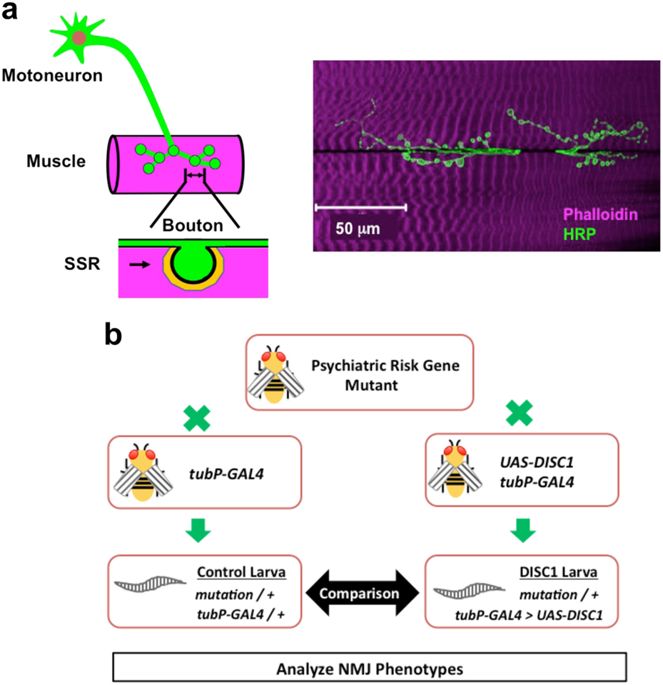npj Schizophrenia ( IF 5.7 ) Pub Date : 2017-10-27 , DOI: 10.1038/s41537-017-0040-6 Himani Pandey , Katia Bourahmoune , Takato Honda , Ken Honjo , Kazuki Kurita , Tomohito Sato , Akira Sawa , Katsuo Furukubo-Tokunaga

|
Originally identified at the breakpoint of a (1;11)(q42.1; q14.3) chromosomal translocation in a Scottish family with a wide range of mental disorders, the DISC1 gene has been a focus of intensive investigations as an entry point to study the molecular mechanisms of diverse mental dysfunctions. Perturbations of the DISC1 functions lead to behavioral changes in animal models, which are relevant to psychiatric conditions in patients. In this work, we have expressed the human DISC1 gene in the fruit fly (Drosophila melanogaster) and performed a genetic screening for the mutations of psychiatric risk genes that cause modifications of DISC1 synaptic phenotypes at the neuromuscular junction. We found that DISC1 interacts with dnrx1, the Drosophila homolog of the human Neurexin (NRXN1) gene, in the development of glutamatergic synapses. While overexpression of DISC1 suppressed the total bouton area on the target muscles and stimulated active zone density in wild-type background, a partial reduction of the dnrx1 activity negated the DISC1–mediated synaptic alterations. Likewise, overexpression of DISC1 stimulated the expression of a glutamate receptor component, DGLURIIA, in wild-type background but not in the dnrx1 heterozygous background. In addition, DISC1 caused mislocalization of Discs large, the Drosophila PSD-95 homolog, in the dnrx1 heterozygous background. Analyses with a series of domain deletions have revealed the importance of axonal localization of the DISC1 protein for efficient suppression of DNRX1 in synaptic boutons. These results thus suggest an intriguing converging mechanism controlled by the interaction of DISC1 and Neurexin in the developing glutamatergic synapses.
中文翻译:

DISC1和神经毒素在果蝇谷氨酸能突触发生中的遗传相互作用
DISC1基因最初是在患有多种精神障碍的苏格兰家庭中的(1; 11)(q42.1; q14.3)染色体易位的断点处发现的,已成为深入研究的重点,是进入这一领域的切入点研究各种心理功能障碍的分子机制。DISC1功能的扰动会导致动物模型中的行为改变,这与患者的精神疾病有关。在这项工作中,我们已经在果蝇(果蝇(Drosophila melanogaster))中表达了人类DISC1基因,并进行了精神疾病风险基因突变的基因筛选,这些基因会引起DISC1突触表型在神经肌肉接头处的修饰。我们发现DISC1与dnrx1相互作用,dnrx1是人类神经氨酸(NRXN1)基因的果蝇同源物,在谷氨酸能突触的发育中发挥作用。尽管DISC1的过表达抑制了目标肌肉上的总钮扣面积,并刺激了野生型背景中的活动区密度,但dnrx1活性的部分降低却抵消了DISC1介导的突触改变。同样,DISC1的过表达在野生型背景中刺激了谷氨酸受体组分DGLURIIA的表达,但在dnrx1杂合背景中却没有刺激。此外,DISC1导致在dnrx1杂合背景下,大的果蝇PSD-95同源物圆盘的错误定位。对一系列结构域缺失的分析表明,DISC1蛋白的轴突定位对于有效抑制突触钮扣中DNRX1的重要性。因此,这些结果表明,在正在发展的谷氨酸能突触中,由DISC1和Neurexin相互作用控制的有趣的收敛机制。











































 京公网安备 11010802027423号
京公网安备 11010802027423号